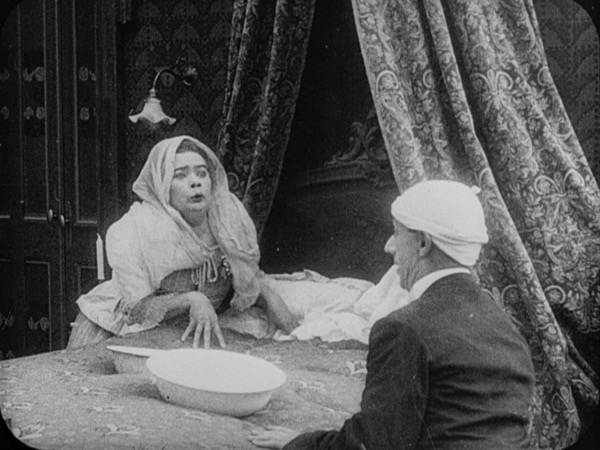LA PAURA DEGLI AEROMOBILI NEMICI
André Deed (IT 1915)
War cannot be shut out by closing a door. It will come back in through a window, or, worse, through a hole in the floor. That, at least, is the lesson to be learned in La paura degli aeromobili nemici [Fear of Enemy Aircraft], a free-wheeling comedy dealing with war that is a key title in the substantial filmography of the best-loved comic character of Italian silent film, Cretinetti, alias André Deed (real name André Chapais, 1879-1940).
Just married to his sweetheart Dulcinea, our hero makes his way to the wedding feast with the usual gaggle of friends and relatives. Not even his mother-in-law seems able to spoil his perfect bliss. On the way, though, the party’s attention is attracted by a notice posted on a wall: it contains instructions on what to do in the event of an air raid on the town. The bridegroom panics at the prospect of an enemy attack, and is driven to apply the preventative measures to the nth degree – and beyond…
The film was released in 1915, when Italy had been at war for just a few months. The world, and cinema, were no longer what they had been in the early, carefree years of the 20th century, when comedy films had been the dominant genre in Italian cinema. This film has no lack of traditional comic set-pieces: water being poured into every conceivable type of container, including wicker baskets and bathtubs; various scenes of wholesale domestic destruction, involving water receptacles (Cretinetti stumbles over everything on “tin legs” when he steps into two tall ones) and sandbags. But the success of the storytelling is built primarily on a spot-on psychological portrayal of the situations and characters, in particular the many-sided, tender, and ethereal relationship between Cretinetti and his bride. To achieve this special feeling, Deed leans trustingly on the Junoesque shoulders of his co-star Léonie Laporte, a first-rate comedienne, here really in a state of grace. Just observe how in the bedroom scene, for instance, notwithstanding gags and sexual innuendo, he succeeds in combining comic effect with an atmosphere of believable conjugal tenderness.
On closer scrutiny, the ending of La paura degli aeromobili nemici is no laughing matter. It is very different from, for example, the cheerful propaganda proffered by such films as Maciste alpino (1916). After destroying his house in the act of defending it against a non-existent air raid, the hapless Cretinetti is informed of his immediate conscription by two gendarmes, who promptly drag him away in front of a supplicant Dulcinea. Between laughs, the suggestion is not only that war is dangerous, but rather that as a naïve individual is enveloped by the neurosis of official propaganda, the real danger lurks in a state that destroys the liberty of the individual, tearing him from his loved ones and marching him off to die at the front. This was a highly non-conformist message for its time, making this film one of the few examples of a sincerely anarchist spirit in Italian silent films.
The starting point for this restoration was a safety duplicate negative with English intertitles. The Italian intertitles were reconstructed using production materials conserved at the Museo Nazionale del Cinema in Turin and flash titles from an incomplete nitrate print held by the Cineteca Nazionale in Rome.
Stella Dagna

photog: Segundo de Chomón.
cast: André Deed (Cretinetti), Léonie Laporte (Dulcinea), Felice Minotti, Domenico Gambino.
prod: Itala Film, Torino.
première: 20.02.1915 (Roma).
copia/copy: 35mm, 336 m., 17′ (18 fps); did./titles: ITA.
fonte/source: Museo Nazionale del Cinema, Torino.
Restauro/Restored: 2005, Museo Nazionale del Cinema, Cineteca di Bologna (lab. L’Immagine Ritrovata).


 Italiano
Italiano